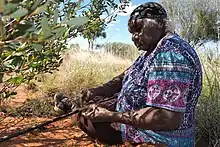The witchetty grub (also spelled witchety grub or witjuti grub[1]) is a term used in Australia for the large, white, wood-eating larvae of several moths. In particular, it applies to the larvae of the cossid moth Endoxyla leucomochla, which feeds on the roots of the witchetty bush (after which the grubs are named) that is widespread throughout the Northern Territory and also typically found in parts of Western Australia and South Australia,[2] although it is also found elsewhere throughout Australia.
The term can also apply to larvae of other cossid moths, ghost moths (Hepialidae), and longhorn beetles (Cerambycidae). The term is used mainly when the larvae are being considered as food. The grub is the most important insect food of the desert and has historically been a staple in the diets of Aboriginal Australians.[3]

Terminology
The Arabana term for the grub is mako witjuti (with emphasis on initial syllables); mako means grub, and witjuti refers to the shrub, not the grub itself.[4] Similarly, Ngalea peoples called the insect "mako wardaruka", meaning grubs of the wardaruka (Acacia ligulata) shrub.[5] The Pitjantjatjara name is "maku".[6] It has been suggested that the word "witchetty" comes from the Adynyamathanha word wityu, meaning "hooked stick", and vartu, meaning "grub".[3]
Description

The different larvae are said to taste similar, probably because they have similar wood-eating habits. Edible either raw or lightly cooked in hot ashes, they are sought as a high-protein food by Aboriginal Australians. The raw witchetty grub tastes similar to almonds,[7] and when cooked, the skin becomes crisp like roast chicken, while the inside becomes light yellow, like a fried egg.[3]
These grubs live in trees. They can also be found in black wattle trees, and are considered to be the reason why wattles die within 10 to 15 years. The roots of the Acacia kempeana shrub are another source of the grubs.[8]
When held, as a defence mechanism, the grubs will secrete a brown liquid.[3]
Cultural significance
Witchetty grubs feature as Dreamings in many Aboriginal paintings.[3]
See also
References
- ↑ "CSIRO - Witjuti grub". Archived from the original on 28 July 2016. Retrieved 15 December 2016.
- ↑ Marshall Cavendish Corporation (2003). Insects and Spiders of the World. Marshall Cavendish. p. 625. ISBN 978-0-7614-7344-2.
- 1 2 3 4 5 Isaacs, Jennifer (2002). Bush Food: Aboriginal Food and Herbal Medicine. Frenchs Forest, New South Wales: New Holland Publishers (Australia). pp. 190–192. ISBN 978-1-86436-816-1.
- ↑ Tindale, Norman (1952). "On some Australian Cossidae including the moth of the witjuti (witchety) grub". Transactions of the Royal Society of South Australia. 76: 56.
- ↑ Thurman, Jessa H. (June 2022). "Beyond the pest: Life history, ecology and ethnoentomology of the giant wood moth ( Endoxyla cinereus )". Austral Ecology. 47 (4): 733–747. doi:10.1111/aec.13165. ISSN 1442-9985. S2CID 247577555.
- ↑ "Mimili". Pitjantjatjara Yankunytjatjara Media. Retrieved 15 March 2020.
- ↑ Ceurstemont, Sandrine (6 July 2013). "Inevitable insectivores? Not so fast". New Scientist. 219 (2924): 35. doi:10.1016/S0262-4079(13)61691-7. Retrieved 3 December 2021.
- ↑ "Witchetty grubs". The Australian Museum. Retrieved 12 September 2022.
External links
 The dictionary definition of witchety grub at Wiktionary
The dictionary definition of witchety grub at Wiktionary- Witchetty Grub on Australian Insects